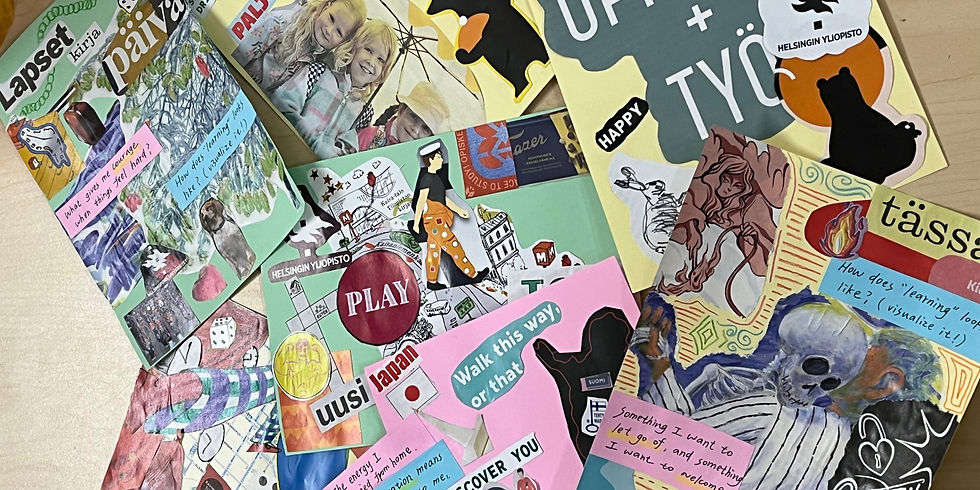Spotlighters: Paths to Resilience With the Science of Stress
- Alicia Lucendo Noriega & Naike Gorr

- Dec 29, 2021
- 5 min read
Updated: Mar 28, 2022
Warm welcome to everyone reading this exciting and very relevant blogpost on ‘paths to resilience with the science of stress’. As this title might have already revealed, this post is dedicated to the science of stress and how we can counteract its long-term effects. If you decide to continue reading this blogpost you will be introduced to questions such as ‘Why do we experience stress?’ and ‘Is there an optimal level of stress?’, followed by suitable resources for the home and classroom environment, and finally a small visual surprise.

Note: Retrieved from http://www.spotlighters.eu
Starting off, from the third to the sixth of November 2021, two Changing Education students (Alicia & Naike) received the opportunity to travel to Barcelona in order to participate in a teacher workshop. This workshop was organized by the Spotlighters project, which is co-funded by the Erasmus+ Programme by the European Union. While the overall aim of the project is to enhance teacher and student awareness as well as coping strategies for the potential long-term effects of stress, the teacher workshop specifically focuses on preparing teachers to enhance student resilience. In order to achieve this aim and to increase the efficiency, the project and its founders try to bridge the gap between research and practice. As it is quite difficult to share three full days worth knowledge within a single blogpost, we decided to provide a brief introduction to the topic as well as the opportunity to continue learning about this topic by following a MOOC (more on this later).
Prior to guiding you through what we have learned, we would like to ask you to complete this very short survey which can be accessed via the link below. Please note that this link is a mock version on how you can use the classmood tool in class. The data will not be gathered for any research purposes, and will be deleted.
Visit: Classmood and enter the lesson code: 1PHGV67Now that you have been provided with a short introduction concerning the workshop, we will continue this post with actual content knowledge. So, let's start by asking "What is stress and why do we experience it?”. Generally, stress is how our body responds (i.e., physiological response) to a perceived threat and includes symptoms such as an increase in heart rate, sweat, and dilated pupils. While the stress response system is innate and present in every human being we also share this system with other non-human animals. The evolutionary perspective reveals that in the past, our most encountered threats were actual physical threats, such as an encounter with a bear. Nowadays, however, while still experiencing the stress response when encountering a bear, we also experience
stress when being late for class, having a full schedule, needing to meet a deadline, and many more. Thus, you see that while back then the stress response was vital for reacting in situations of immediate threat to our survival, it nowadays is pretty much always active. In this context we have learned that the actual purpose of the stress response is the preparation of our body to quickly react to the immediate threat.
This leads to the second topic, namely the three automatic survival behaviors. As we have learned in the workshop, these survival behaviors comprise freezing, fighting, and fleeing, which you can most likely relate to. In the context of the classroom, a student might freeze when being called out by a teacher, verbally fight when treated unfairly by his or her peers, or try to flee the responsibility of needing to present by staging an illness in the morning.
Finally, we discussed the question of whether there is an optimal stress level for learning and performing. The answer is, yes, but it is complicated. As we have learned in the workshop, when investigating the amount of stress one needs to experience to perform at the highest level it looks somewhat like an inverted U shape (see picture). Here, experiencing too little stress leads to being demotivated while experiencing too much stress is also counterproductive as you become nervous. This relation of experiencing too little, an optimal level, and too much is depicted in the graph below. Taking this relation into consideration is of importance when wanting to support your students for performing at a good level.
Yerkes-Dodson Law (U-Curve)

Note: Beardsley, M. (2021).
If you found this information as relevant and helpful as we did, you could consider signing up for the Spotlighters Free Online Course ‘The Science of Stress and Self-Regulation’. This MOOC will guide you through a total of seven units comprising more relevant content knowledge and the most common stress management techniques. Among others, this course addresses questions such as: “What is a stress mindset and how can we teach our students?” “Why is self-regulation considered a skill?” and “How can we relearn how to breathe?” The course is suitable both for the classroom environment as well as your personal interest, and is available in a total of five languages (including Finnish and English). If you are interested, please see this link for more information. But enough reading for now! Let’s move a little bit with this energizing exercise:
Has this energizer changed your mood, and if so, how? What about reading this blogpost?
Once you have done the energizer, please visit:
Classmood and enter the following lesson code: XJLQG5KGenerally, the Classmood tool is one of the free resources developed by the Spotlighters project, with the aim of supporting educators in firstly assessing and secondly establishing an appropriate learning environment. In order to use this free resource, you just need to create an account, prepare a mood measure, and share the code with your students who will be able to respond to it anonymously. Implementing this resource into your teaching allows you not only to assess the general classroom mood but also the change in classroom mood over time (multiple measures), the effectiveness of certain activities (pre- and post-measure), differences between groups (comparative measure), and to teach emotion regulation. So now that you know its applicability and enabled opportunities, how would you use it in your classroom?
In addition to the already mentioned MOOC and Classmood app, there is also a great variety of resources you can access through the Spotlighters website and youtube. These include videos of potential exercises comprising both energizers and calming activities.
Finally, as promised at the beginning, here is our surprise. Our friend Moomin also wanted to participate in the workshop to learn more about the science of stress while discovering the city of Barcelona. So, if you would like to see its trip, click on the video below!
References
[Untitled illustration of Spotlighters project]. Spotlighters. http://www.spotlighters.eu
Beardsley, M. (2021, November 3). Yerkes-Dodson Law [PowerPoint presentation]. Spotlighters.
About the Authors

Hi, I am Alicia Lucendo Noriega, a primary education and music teacher, studying my second year of the Changing Education Master’s Programme. I am passionate about music and education, to learn more how to connect these field to change education!

Hey there! My name is Naike Gorr and with an academic background in psychology I am currently studying the Changing Education Master’s program. While my research interest covers a wide variety of topics, I am most passionate about improving education to prepare the current generations for the upcoming challenges by taking an educational policy perspective.




Comments